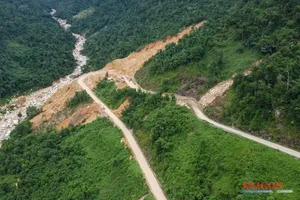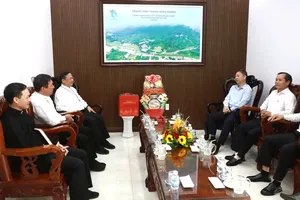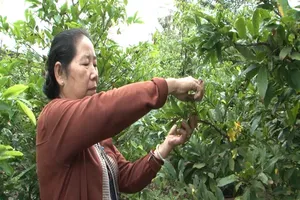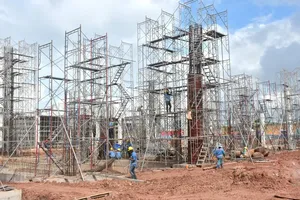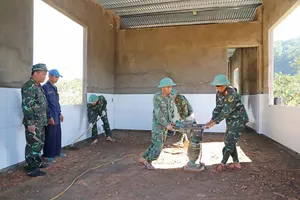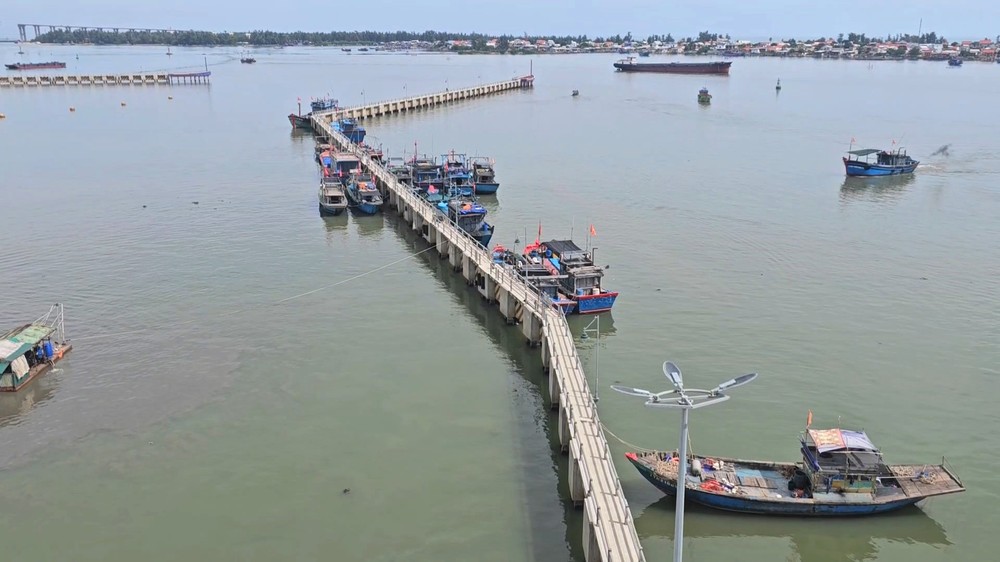
In addition to the projects that genuinely support offshore fishing activities, there are still some that have received billions of Vietnamese dong in investment but have proven ineffective, failing to attract ships for entry and exit. Some projects have even been abandoned, damaged, or degraded after construction.
Central region constructs idle port
Thuan An fishing port located in the Central city of Hue’s Thuan An Ward has been completed and handed over to the management unit for almost a year, yet the port has not been officially opened. After receiving compensation funds from Hung Nghiep Formosa Ha Tinh Steel Company Limited, Thua Thien Hue Province has used the money for the launch of a project to upgrade fishing infrastructure, with a total investment of VND400 billion whose investor is the provincial Department of Agriculture and Rural Development.
Thuan An fishing port, which also serves as a storm shelter, is one of three component projects with a total investment of VND220 billion. Construction of the project commenced in 2019, with an initial completion target set for 2021. However, various factors contributed to delays, resulting in the project not being finalized until the end of 2023, at which point it was officially handed over to the Thua Thien Hue Fishing Port Management Board.
The Thua Thien Hue Fishing Port Management Board has failed to operationalize the newly constructed Thuan An fishing port. The lack of necessary permits has left the port abandoned and neglected. During the dry season, the port's yard is inappropriately used for seafood drying by local residents.
Deputy Director Nguyen Thanh Son from the Thua Thien Hue Fishing Port Management Board disclosed that the Thuan An fishing port project, which has been under construction for five years, is still awaiting official land and water allocation decisions. This delay has prevented the authorities from issuing the necessary permits for the port's operation.
The missing land and water allocation approvals were a major impediment to the successful completion of the port's opening procedures.
Thai Van Phuc from the Department of Agriculture and Rural Development, revealed that the Thuan An fishing port project was initiated on the existing land and water surface of the old port, without considering the need for formal land use and allocation approvals. This oversight has now become a major hurdle in the process of obtaining the necessary permits for the port's operation.
Last but not least, although the Thuan An fishing port project has been handed over to the competent management unit, the current status of the channel has not been dredged, causing difficulties for fishing boats to enter and exit. This fact also affects the port opening announcement procedure for Thuan An fishing port.
In Ha Tinh Province, Xuan Hoi fishing port, located in Xuan Hoi Commune of Nghi Xuan District, was established in 2009 with an investment exceeding VND110 billion. The 128-meter-long wharf became operational in 2011, and by 2014, the entire project was fully functional.
Previously, the port facilitated the daily entry and exit of 30 to 50 vessels from both within and outside the province for seafood trading. However, in recent years, the port has suffered from significant siltation, hindering vessel access and leading to a decline in interest from ship owners. This situation has adversely impacted the production, business, and logistics services for residents of Xuan Hoi Commune, resulting in the port's functions not being utilized to their full potential as initially anticipated.
Infrastructure is inadequate while investment is minimal
The ongoing decline of Tam Quan fishing port in the Central province of Binh Dinh’s Hoai Nhon Town has raised concerns among local fishermen. They attribute this issue to the insufficient investment and sporadic dredging of the port's waterways over the years. Despite having a robust fishing fleet and numerous fisheries-related services and enterprises, the port's narrow entrance acts as a bottleneck, hindering the growth of this fishing hub.
Fisherman Nguyen Lanh in Tam Quan Nam Ward, emphasized that the infrastructure investment and dredging efforts in Tam Quan have been inconsistent and merely temporary solutions. Often, the dredged channels are quickly filled again within a few days.
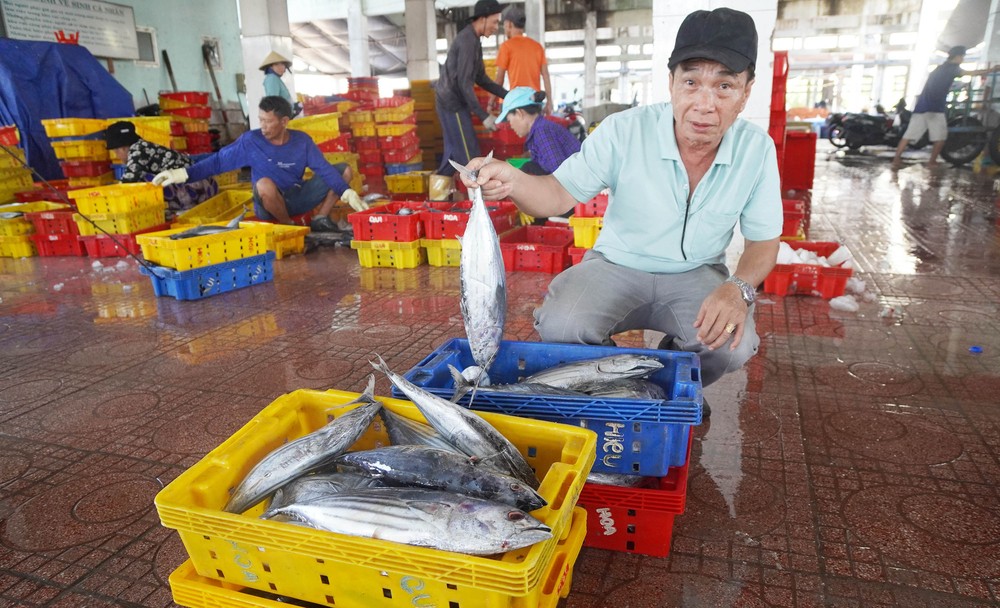
Deputy Director Dang Van Dan of the Tam Quan Fishing Port and Urban Services Management Board has observed that the fragmented and insufficient investment in infrastructure poses significant challenges not only for fishermen but also for the fishing port itself. Currently, Tam Quan fishing port is severely lacking in both hard and soft infrastructure.
Specifically, the hard infrastructure is deficient in terms of a well-planned storm shelter, absence of protective embankments, inadequate dredging, narrow waterways, and a lack of fencing, gates, weighing stations, and office facilities. In terms of soft infrastructure, there is a notable shortage of electronic machinery, high-performance computers, communication devices, and an integrated electronic data system for fishing activities.
Director Tran Van Phuc of the Department of Agriculture and Rural Development of Binh Dinh Province has emphasized the province's significant seafood export potential. To fully harness this potential in the long term, the province intends to invest in the comprehensive development of infrastructure, including the construction of storm shelter areas and the establishment of an international standard tuna auction center at Tam Quan fishing port.
Additionally, the province is seeking support from the Ministry of Agriculture and Rural Development to implement the second phase of the tuna project. This phase specifically aims to introduce energy-efficient tuna fishing technologies and modern post-harvest product preservation methods to enhance product quality and pricing.
Director Nguyen Van Muoi of the Fisheries Sub-Department of Quang Ngai Province said that the province has a fishing fleet comprising 4,624 vessels, over 3,000 of which are engaged in offshore fishing. However, the local ports can only accommodate 1,750 vessels, forcing the remaining 60 percent to rely on external ports for docking leading to a decline in the province's fishing capacity and prevention of the full realization of its potential.
Moreover, the investment in port infrastructure remains incomplete and lacks coherence, resulting in management and operational challenges that hinder optimal effectiveness. Furthermore, the annual budget allocation for maintenance and repair of infrastructure is significantly lower than actual needs, and the access channels to the ports and anchorage areas are frequently silted.


